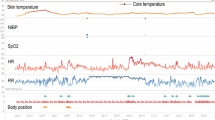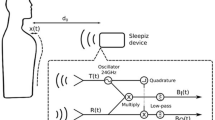Abstract
Background
The present study aimed to explore the association between impending death and continual changes in respiratory and heart rates measured using a non-wearable monitor every minute for the final 2 weeks of life in dying cancer patients.
Methods
In this longitudinal study, we enrolled patients in a palliative care unit and continuously measured their respiratory and heart rates via a monitor and additionally captured their other vital signs and clinical status from medical records.
Result
A dataset was created comprising every 24-h data collected from every-minute raw data, including information from 240 days prior to death from 24 patients (345,600 data); each patient’s data were measured for 3–14 days until death. After confirming the associations between the respiratory and heat rate values on the day of death (n = 24) or other days (2–14 days before death, n = 216) and the mean, maximum, minimum, and variance of respiratory and heart rates every 24 h by univariate analyses, we conducted a repeated-measures logistic regression analysis using a generalized estimating equation. Finally, the maximum respiratory rate and mean heart rate were significantly associated with death occurring within the following 3 days (0–24 h, 0–48 h, and 0–72 h), except for the maximum respiratory rate that occurs within 0–24 h.
Conclusion
The maximum respiratory rate and mean heart rate measured every minute using a monitor can warn family caregivers and care staff, with the support of palliative care professionals, of imminent death among dying patients at home or other facilities.

Similar content being viewed by others
Data availability
All authors shared the raw data. The datasets used and/or analyzed during the current study are available from the corresponding author on reasonable request.
References
Bray F, Ferlay J, Soerjomataram I, Siegel RL, Torre LA, Jemal A (2018) Global cancer statistics 2018. CA Cancer J Clin 68:394–424
Fukui S, Morita T, Yoshiuchi K (2017) Development of a clinical tool to predict home death of a discharged cancer patient in Japan: a case-control study. Int J Behav Med 24:584–592
Ministry of Economy, Trade, And Industry (2020) Economic and social up to 2050 Structural changes and policy issues. https://www.meti.go.jp/shingikai/sankoshin/2050_keizai/pdf/001_04_00.pdf. Accessed 6 January 2021
Simmons CPL, McMillan DC, McWilliams K, Sande TA, Fearon KC, Tuck S, Fallon MT, Laird BJ (2017) Prognostic tools in patients with advanced cancer: a systematic review. J Pain Symptom Manage 53:962–970
Hui D, Paiva CE, Del Fabbro EG, Steer C, Naberhuis J, van de Wetering M, Fernández-Ortega P, Morita T, Suh SY, Bruera E, Mori M (2019) Prognostication in advanced cancer: update and directions for future research. Support Care Cancer 27:1973–1984
Hui D, Shamieh O, Paiva CE, Perez-Cruz PE, Kwon JH, Muckaden MA, Park M, Yennu S, Kang JH, Bruera E (2015) Minimal clinically important differences in the Edmonton Symptom Assessment Scale in cancer patients: a prospective, multicenter study. Cancer 121:3027–3035
Chen YT, Ho CT, Hsu HS, Huang PT, Lin CY, Liu CS, Li TC, Lin CC, Lin WY (2015) Objective palliative prognostic score among patients with advanced cancer. J Pain Symptom Manage 49:690–696
Bruera S, Chisholm G, Dos Santos R, Crovador C, Bruera E, Hui D (2014) Variations in vital signs in the last days of life in patients with advanced cancer. J Pain Symptom Manage 48:510–517
Hwang IC, Ahn HY, Park SM, Shim JY, Kim KK (2013) Clinical changes in terminally ill cancer patients and death within 48 h: when should we refer patients to a separate room? Support Care Cancer 21:835–840
Brabrand M, Knudsen T, Hallas J, Graham CA, Kellett J (2018) The PARIS score can reliably predict 7-day all-cause mortality for both acute medical and surgical patients: an international validation study. Int J Med 111:721–725
Hamano J, Takeuchi A, Yamaguchi T, Baba M, Imai K, Ikenaga M, Matsumoto Y, Sekine R, Yamaguchi T, Hirohashi T, Tajima T, Tatara R, Watanabe H, Otani H, Nagaoka H, Mori M, Tei Y, Hiramoto S, Morita T (2018) A combination of routine laboratory findings and vital signs can predict survival of advanced cancer patients without physician evaluation: a fractional polynomial model. Eur J Cancer 105:50–60
Matsunami K, Tomita K, Touge H, Sakai H, Yamasaki A, Shimizu E (2018) Physical Signs and Clinical Findings Before Death in Ill Elderly Patients. Am J Hosp Palliat Care 35(4):712–717
Hosoi T, Ozone S, Hamano J (2020) Variations in vital signs at the end of life in non-cancer patients: a retrospective study. Ann Palliat Med 9(5):2678–2683
Pavic M, Klaas V, Theile G, Kraft J, Tröster G, Blum D, Guckenberger M (2020) Mobile health technologies for continuous monitoring of cancer patients in palliative care aiming to predict health status deterioration: a feasibility study. J Palliat Med 23:678–685
Gresham G, Schrack J, Gresham LM, Shinde AM, Hendifar AE, Tuli R, Rimel BJ, Figlin R, Meinert CL, Piantadosi S (2018) Wearable activity monitors in oncology trials: Current use of an emerging technology. Contemp Clin Trials 64:13–21
Liu L, Stroulia E, Nikolaidis I, Miguel-Cruz A, Rios RA (2016) Smart homes and home health monitoring technologies for older adults: a systematic review. Int J Med Inform 91:44–59
Brekke IJ, Puntervoll LH, Pedersen PB, Kellett J, Brabrand M (2019) The value of vital sign trends in predicting and monitoring clinical deterioration: a systematic review. PloS One 14(1):e0210875
Gokalp H, de Folter J, Verma V, Fursse J, Jones R, Clarke M (2018) Integrated telehealth and telecare for monitoring frail elderly with chronic disease. Telemed J E Health 24:940–957
Cox A, Illsley M, Knibb W, Lucas C, O’Driscoll M, Potter C, Flowerday A, Faithfull S (2011) The acceptability of e-technology to monitor and assess patient symptoms following palliative radiotherapy for lung cancer. Palliat Med 25:675–681
Ambrosino N, Vitacca M, Dreher M, Isetta V, Montserrat JM, Tonia T, Turchetti G, Winck JC, Burgos F, Kampelmacher M, Vagheggini G (2016) Tele-monitoring of ventilator-dependent patients: a European Respiratory Society Statement. Eur Respir J 48:648–63
Kogure T, Kobayashi M, Okawa T, Nakajima T, Inoue Y (2017) Validation of a sheet-shaped body vibrometer for screening of obstructive sleep apnea. Drug Discov Ther 11:126–132
Kogure T, Ebata T (2018) Activity during sleep measured by a sheet-shaped body vibrometer and the severity of atopic dermatitis in adults: a comparison with wrist actigraphy. J Clin Sleep Med 14:199–204
Morita T, Tsunoda J (1999) Contributing factors to physical symptoms in terminally-ill cancer patients. J Pain Symptom Manage 18:338–346
Downing M, Lau F, Lesperance M, Karlson N, Shaw J, Kuziemsky C, Bernard S, Hanson L, Olajide L, Head B, Ritchie C, Harrold J, Casareti D (2019) Meta-analysis of survival prediction with Palliative Performance Scale. J Palliat Care 23:245–4
Kogure T, Shirakawa S, Shimokawa M, Hosokawa Y (2011) Automatic sleep/wake scoring from body motion in bed:validation of a newly developed sensor placed under a mattress. J Physiol Anthropol 30:103–109
Liang K, Zeger YL (1986) Longitudinal data analysis using generalized linear models. Biometrika 73:13–22
Liu W, Luo M, Fang YY, Wei S, Zhou L, Liu K (2019) Relationship between occurrence and progression of lung cancer and nocturnal intermittent hypoxia, apnea and daytime sleepiness. Curr Med Sci 39:568–575
Silberfarb PM, Hauri PJ, Oxman TE, Schnurr P (1993) Assessment of sleep in patients with lung cancer and breast cancer. J Clin Oncol 11:997–1004
Davenport HW (1974) The ABC of acid-base chemistry: the elements of physiological blood-gas chemistry for medical students and physicians, 6th edn. The University of Chicago Press, Chicago
Taylor P, Crouch S, Howell DA, Dowding DW, Johnson MJ (2015) Change in physiological variables in the last 2 weeks of life: an observational study of hospital in-patients with cancer. Palliat Med 29:120–127
Acknowledgements
The authors would like to thank Masanobu Kawazoe, Mamoru Okumoto, Nobuhiro Nakamura, Tatsuto Suzuki, Ichiro Mori, Yuki Moriki, and Yuko Ohno from the DAIKIN research project team.
Funding
This study was funded by Grant-in-Aid for Scientific Research B by the Ministry of Education, Culture, Sports, Science and Technology (18H03112) and a research grant from Daikin Industry. This article was also supported by the Clinical Investigator’s Research Project at the Osaka University Graduate School of Medicine.
Author information
Authors and Affiliations
Contributions
SF managed this study as a principal investigator. MY, MU, HT, YH, and AH designed the study. KI, IM, and YH collected the data and created a dataset. SF and SH analyzed the data. SF, KI, IM, and SH drafted the report. All authors have read and approved the final report.
Corresponding author
Ethics declarations
Ethics approval and consent to participate
This study was conducted with the approval of the Ethics Review Committee of Intervention Studies and Observational Research, Osaka University Hospital (approval number: 1741110). After explaining the study protocol to eligible patients, written informed consent was obtained from each patient. Participation in the study was voluntary, and patients were informed that all data would be anonymous and their privacy and personal information would be protected. If a patient did not have sufficient mental capacity to decide on study participation, written consent was obtained from the patient’s family/proxy.
Consent for publication
All authors have approved for publication of this report in BMC Medical Research Methodology.
Competing interests
The authors declare no competing interests.
Additional information
Publisher’s note
Springer Nature remains neutral with regard to jurisdictional claims in published maps and institutional affiliations.
Highlights
• Non-wearable monitor measures respiratory and heart rate changes in dying patients
• Maximum respiratory rate was significantly associated with death within the next 3 days
• Mean heart rate was significantly associated with death within the following 3 days
• Monitoring vital data in dying patients enhances quality care
Supplementary Information
Below is the link to the electronic supplementary material.
Rights and permissions
About this article
Cite this article
Fukui, S., Ikuta, K., Maeda, I. et al. Association between respiratory and heart rate fluctuations and death occurrence in dying cancer patients: continuous measurement with a non-wearable monitor. Support Care Cancer 30, 77–86 (2022). https://doi.org/10.1007/s00520-021-06346-y
Received:
Accepted:
Published:
Issue Date:
DOI: https://doi.org/10.1007/s00520-021-06346-y




